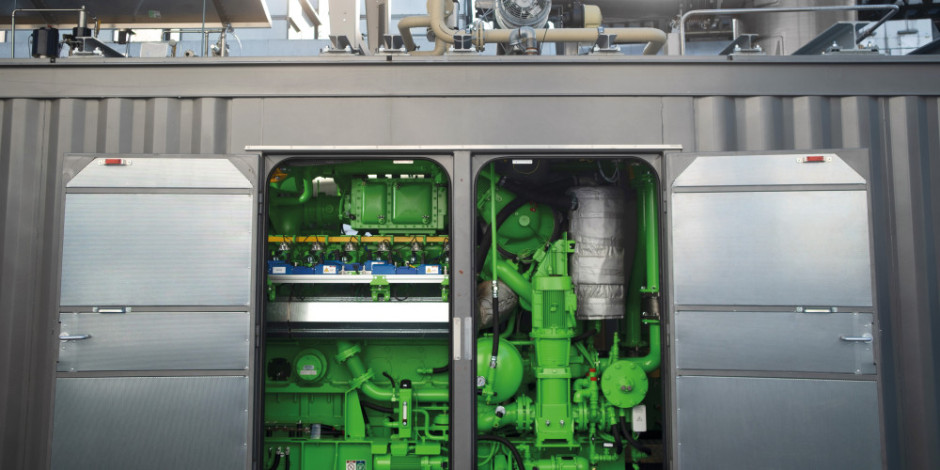Green hydrogen (H2) can be used as a synthetic fuel in stationary engines for power generation without any other chemical conversion. In addition, it can be used to produce ammonia, methanol, or long-chain hydrocarbons, which also are suitable as energy sources. Known as e-fuels, they enable a carbon-neutral or, in the case of green H2 and ammonia, even a carbon-free power supply, and therefore are a driving force in the transition from fossil fuels to renewable energy sources.

2°C
to the Paris Agreement
on climate change
50–60%
in the EU
As the proportion of CO2 in the Earth’s atmosphere increases, the world’s climate is changing, and average global temperatures are rising. Globally, the world is about 1.2°C warmer than it was in the pre-industrial period, and temperatures are expected to continue to rise. CO2 emissions must be drastically reduced to meet the 2°C maximum increase targeted in the Paris Agreement on climate change. To achieve this, the transition from fossil fuels to renewable energy sources should take place as quickly as possible. The major industrialized nations are pursuing a decarbonization agenda to meet this challenge and facilitate the transition to a sustainable energy industry. In addition to the electrification of private transport, more oil and gas heating systems are being replaced with heat pumps. As a result, the demand for electrical energy is showing significant increases. In addition to the purely quantitative challenge of meeting this power demand from renewable sources, there is the difficulty of ensuring that consumption and generation are always balanced on the grid. Wind and solar power are not always available in sufficient quantities at all times. While large amounts of renewable energy can be produced on a windy summer day, the yield is much lower on a cloudy day with little wind in the fall. Efficient energy storage systems are therefore also essential for a successful energy transition, as they can step in when there is no wind or solar power to produce.
Power-to-X storage solutions
Battery systems are not suitable for storing the large amounts of power required to balance out medium-term or even seasonal fluctuations. However, power-to-X technologies, which convert electrical energy for storage purposes into e-fuels such as ammonia, are a promising solution. Around 50% to 60% of the energy required in the EU is imported, increasingly from renewable energy sources. As regions with a constant and abundant supply of sun and wind are too far from areas without those renewable resources for the electricity to be transported over high-voltage lines, conversion into chemical energy sources using the power-to-X process is an excellent solution. Although expanding the European hydrogen grid and repurposing the existing natural gas grids will enable the distribution of hydrogen on a large scale, the intercontinental transport of natural gas is now increasingly taking place in liquid form, such as LNG. The process of liquefying hydrogen for transport purposes is much more complicated and expensive than it is for natural gas. Ammonia, on the other hand, is much easier to produce and liquefy, making it a great candidate for transporting larger volumes across longer distances.
Hydrogen und ammonia as carbon-free energy sources
Because e-fuels are converted into energy in modern large engines, they can make a significant contribution to decarbonization – especially if they run on green hydrogen and ammonia as completely carbon-free fuels. The INNIO Group offers an engine system – the Jenbacher Type 4 – that can run on 100% hydrogen, and the company also is developing innovative technologies for ammonia. For instance, the use of ammonia without the need for an additional ignition fuel has been demonstrated successfully on a research engine. In 2025, the INNIO Group plans to introduce solutions for the use of 100% hydrogen with larger engines with several megawatts of power. Once again, these INNIO Group innovations have positioned the company at the heart of the energy transition.
100%
H2-ready
Jenbacher Type 4 engine
1 MW
<p>ammonia
<br>engine</p>
This article is adapted from the article published in MTZ “E-fuels play a key technological role in decarbonization” by Matthias Veltman, Stephan Laiminger, Michael Url, and Klaus Payrhuber. Read the full article here.

Dr. techn. Dipl.-Ing. Stephan Laiminger is Chief Technologist for the INNIO Group’s Jenbacher product brand.

M.Eng. / MBA Matthias Veltman is the Engineering Platform Leader for E-Fuels and Special Gases for the INNIO Group’s Jenbacher product brand.

Dr. techn. Dipl.-Ing. Michael Url is Senior Engineer for the INNIO Group’s Jenbacher product brand.

Dr. techn. Dipl.-Ing. Klaus Payrhuber is Product Manager Marketing & Strategic Product Development for the INNIO Group’s Jenbacher product brand.